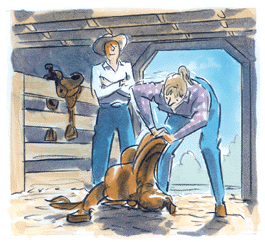|
The tree--that is, the wood (sometimes plastic) form the saddle is built on--is the most important piece to check. If the tree is broken, the saddle will hurt
your horse.

"I inspect the tree two ways," Hanks explained, referring to English saddles. "First, put the cantle on the upper thigh and bring the pommel up towards you. Grab each part of the saddle and pull. Listen for squeaking or motion. That could mean anything from broken plates to a broken tree."
Then turn the process around, resting the pommel on the upper thigh.
"Grab the pommel and go along the bars, pushing down to see if anything moves. These days, many saddles have flexible trees, but if there is movement, you want to see the 'give' evenly the whole way through. Look for a place where the leather wrinkles; that could mean a cracked bar."
Check the billets to see how much life is left in them. "Look at the webbing; look up high as you can. If the web is worn and lets go while you're riding, well, you won't have a girth anymore," he advised.
Checking out the stirrup bars is essential. "If you're going to use them properly, they should move easily up and down. They should also be secure. Any motion in the stirrup bars shows that the steel or wood is getting sloppy, or there are popped or sheared rivets."
Turn the saddle upside down and analyze the panels. What are they stuffed with? Do they seem smooth? If they're not smooth, chances are the material inside--whether flock, foam or fiber--has broken down.
General appearance can tell you a lot. "Has the saddle been taken care of? Is the stitching separating? If it's separated, is it from rot or abrasion? Rot probably means that all of the stitching in the saddle is rotten and will need to be replaced," Hanks says.
Similar checks are necessary when buying a Western saddle. Safety comes first, and a sound tree is essential.
"A simple way to check the tree is to place the saddle on the floor, pommel down," explained Bruce King of Kings Saddlery in Sheridan, Wyo. "Be sure to test it on a floor with no give. Push on the cantle. If you see movement in the middle of bars, the tree may be broken or there's something loose.
"Look for bare spots in the fleece lining underneath. Are there screws and nails popping out? Look at the stitching everywhere to make sure it's not rotting. Pick up each skirt and carefully look underneath to see if anything is wrong," he said.
The saddle horn should be solid; try rocking it. Grab the sides of the stirrups and move them around a bit to make sure they're not broken.
King says the stirrup leather can get worn at the very top where it rubs against the metal bar. "Pull that stirrup leather all the way out and look high at the top to make sure it's not too worn.
Also, look at the stirrup leather holes to make sure they're not torn. Look at the hobble strap where the stirrup hangs. Many times that's covered up and you can't see if there is a tear. Go over everything," he stressed.
Both men agree a quality saddle is essential to enjoying your horse. The condition of that leather is everything.
"There's nothing more frightening than having things breaking while you're riding," King says. "If you find a problem, you need to consider if it's worth repairing. In some cases you'll spend more on repairs to a used saddle than you would buying a new one."
If it's a good saddle at a good price and needs some work, it might be worth it, Hanks adds. "But if it's not a quality saddle to begin with, it's not worth fixing."
Used or abused?
by Anna Carner Blangiforti
Quality cleaners and conditioners can restore suppleness and good looks to even seemingly hopeless cases, but they are not magic. Don't waste your time on poor leather.
You can draw the line between useful and useless by realizing how you plan to use the item. You also need to know if the strength of the leather was gone before you started cleaning it, if it was good leather to begin with and if it was properly cared for.
Are you dealing with an old halter or leather lead that could break without resulting in disaster? Is this used bridle, billet or girth strong and sound enough to be safe?
Clean the leather. As long as the mold and mildew have not deteriorated the stitching, the tack probably still has some useful life. When leather becomes completely dried out and stiff, however, its internal matrix becomes brittle. Though conditioners can lubricate the leather and restore its suppleness, they cannot replace broken internal bonds or rebuild strength.
Put leather to the test. Bend and pull it forcibly in every direction; try to tear the leather and the stitching. If the leather shows any tendency to stretch, crack, open up with multiple tiny fissures or crumble where it meets metal fasteners, it's beyond restoration.
Keep in mind that leather can only be as good as the hide from which it was made. Buy the best you can afford then take care of it right to protect your investment.
Anna Carner Blangiforti is the founder and president of Leather
Therapy Products
|

|